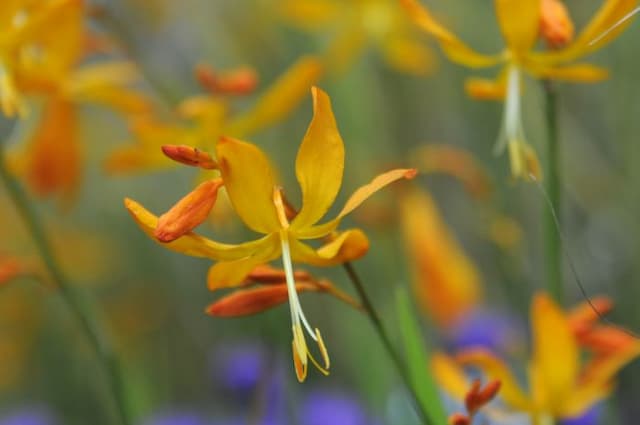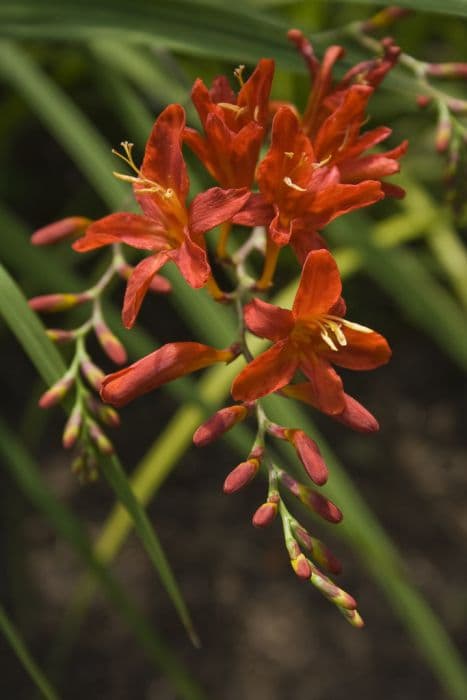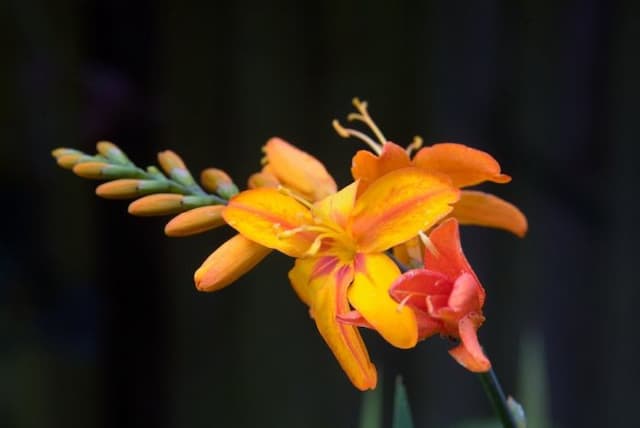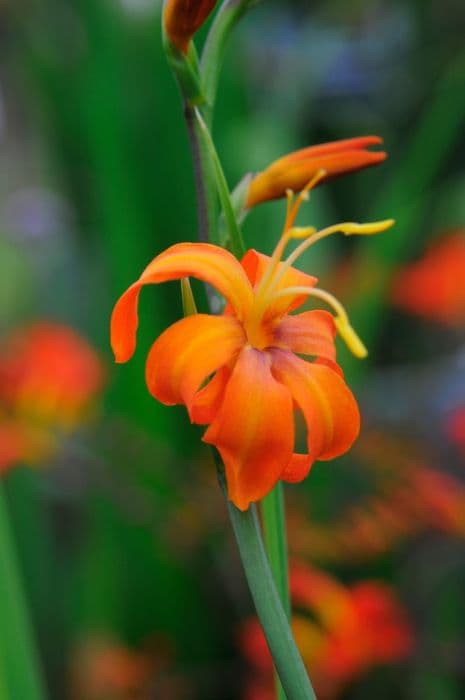Tukauki Libertia ixioides

ABOUT
Libertia ixioides, commonly known as Tukauki or Mikoikoi, is an eye-catching plant with striking features. It presents a tough, clumping habit with long, narrow leaves that are sword-shaped and often pointed at the ends. The leaves are a notable feature, typically displaying a bright green color that can vary or change to yellow, orange, or bronze hues, especially during cooler seasons, adding a touch of autumnal color to the garden. This color transition is one of its most distinctive characteristics and makes it a popular choice for adding year-round aesthetic appeal. The plant produces small, attractive flowers that are borne on slender, branching stems that rise above the foliage. These flowers are typically white and star-shaped, which adds to its ornamental value. The blooms usually appear in late spring or early summer, and they may stay for a good period, offering a nice contrast with the rigid foliage. As the flowering season ends, the plant develops capsules that can add visual interest. Over time, these may open up to release seeds for propagation. The overall structure and form of Tukauki make it a favored choice for gardeners looking to add texture and a touch of wild elegance to their planting schemes. Its durability and striking foliage, combined with the delicate flowers and seed capsules, create an alluring display that is admired by many.
About this plant
 Names
NamesFamily
Iridaceae
Synonyms
Tukauki, Mikoikoi, New Zealand Iris, Native Iris
Common names
Libertia chilensis, Sisyrinchium ixioides.
 Toxicity
ToxicityTo humans
The plant commonly known as New Zealand iris, Libertia ixioides, is generally not considered toxic to humans. There is limited information on the toxicity of this plant to humans and it is not known to cause poisoning if ingested. However, it is always advisable to avoid eating any plant parts if you are unsure of their edibility and to consult a medical professional or a poison control center for advice on plant toxicity.
To pets
New Zealand iris, or Libertia ixioides, is not commonly listed as a toxic plant for pets. There is no well-documented evidence of it causing poisoning in domestic animals. Nonetheless, it is prudent to prevent pets from ingesting plants not intended for consumption, as individual animals may have different sensitivities or allergies. If you suspect your pet has ingested this plant and is showing adverse symptoms, contact your veterinarian.
 Characteristics
CharacteristicsLife cycle
Perennials
Foliage type
Evergreen
Color of leaves
Green
Flower color
White
Height
2 feet (0.6 meters)
Spread
2 feet (0.6 meters)
Plant type
Herb
Hardiness zones
8
Native area
New Zealand
Benefits
 General Benefits
General Benefits- Ornamental Value: Libertia ixioides, commonly known as Tukauki, adds aesthetic appeal to gardens with its striking, evergreen foliage and star-like, white flowers.
- Drought Resistance: This plant is quite hardy and can tolerate dry conditions, making it suitable for drought-prone regions.
- Low Maintenance: Tukauki requires minimal care once established, making it a convenient choice for gardeners seeking low-maintenance plants.
- Soil Adaptability: It can thrive in a variety of soil types, as long as they are well-draining.
- Cold Tolerance: Libertia ixioides has good resistance to cold temperatures, which allows it to be grown in many temperate climates.
- Wildlife Attraction: The flowers can attract pollinators such as bees, providing a beneficial relationship between the plant and the local ecosystem.
- Erosion Control: Tukauki can help in stabilizing soil and preventing erosion with its robust root system.
- Architectural Structure: The plant's upright form provides a strong visual structure in garden design, often used in mass plantings for a dramatic effect.
- Year-Round Interest: With foliage that stays green throughout the year and seasonal blooms, it contributes to a garden's visual appeal across all seasons.
- Ground Cover: When planted in groups, Libertia ixioides provides an effective ground cover, reducing weed growth and covering bare spots in the landscape.
 Medical Properties
Medical PropertiesThis plant is not used for medical purposes.
 Air-purifying Qualities
Air-purifying QualitiesThis plant is not specifically known for air purifying qualities.
 Other Uses
Other Uses- Libertia ixioides, commonly known as mikoikoi, can be used as a structural element in gardens due to its distinctive, stiff, and upright foliage, which provides a strong vertical accent in landscaping designs.
- The plant's seed pods can be utilized in dried floral arrangements, adding a unique texture and visual interest to the composition.
- Mikoikoi can be planted to form low hedges or borders along walkways, offering a minimalist and contemporary look.
- The strikingly white flowers of the mikoikoi may be used to complement nighttime or moon gardens, as they can reflect moonlight and create a luminous effect.
- Due to its dense growth habit, mikoikoi can be used for ground cover to suppress weeds in garden beds, reducing the need for mulching and maintenance.
- Mikoikoi's long leaves can be woven into traditional Maori textiles or artworks, although this is more of a cultural than a common use.
- In garden ponds or water features, the mikoikoi's foliage provides a contrasting texture to aquatic plants, while not being invasive or overly dominant.
- Photographers and artists may use the plant as a subject or backdrop for portraits and macro photography, particularly when the plant is in bloom.
- Its robust nature and resilience to coastal conditions make mikoikoi a reliable choice for seaside gardens, helping to stabilize sandy soils and provide shelter for other plants.
- The mikoikoi can be used in urban planting schemes, as it can tolerate some of the environmental stresses found in city environments such as compacted soils and pollution.
Interesting Facts
 Feng Shui
Feng ShuiThe New Zealand Iris is not used in Feng Shui practice.
 Zodiac Sign Compitability
Zodiac Sign CompitabilityThe New Zealand Iris is not used in astrology practice.
 Plant Symbolism
Plant Symbolism- Endurance: The hardy nature of Libertia ixioides, also known as New Zealand Iris, often symbolizes the ability to endure challenging conditions and persevere through adversity.
- Purity: The white flowers of the New Zealand Iris are frequently associated with purity and innocence, reflecting its clean and crisp appearance.
- Freedom: With its natural habitat in open spaces, the New Zealand Iris can symbolize a sense of freedom and the importance of open environments.
- Adaptability: As a plant that can thrive in a variety of soil types and levels of sunlight, the New Zealand Iris may represent flexibility and the ability to adapt to changing circumstances.
 Water
WaterThe New Zealand Iris should be watered moderately, allowing the top inch of soil to dry out slightly before watering again. Typically, this plant requires watering approximately once a week, but this can vary depending on temperature and humidity conditions. It's best to provide about 1 gallon of water per plant during each watering session to ensure the soil is evenly moistened but not waterlogged. During the winter months, reduce watering frequency as plant growth slows down. Always ensure the plant has good drainage to prevent root rot.
 Light
LightNew Zealand Iris thrives in full sun to partial shade. It prefers a spot where it can receive at least six hours of sunlight a day. However, in extremely hot climates, some afternoon shade is beneficial to prevent scorching of the leaves. Ideal locations can include east or west-facing gardens where the plant will receive sunlight with some protection from the intense midday sun.
 Temperature
TemperatureNew Zealand Iris is hardy and can tolerate a wide range of temperatures but performs best when the temperature is between 60 and 75 degrees Fahrenheit. It can survive minimum temperatures down to about 10 degrees Fahrenheit but may require protection from frost. Avoid exposing the New Zealand Iris to sudden extreme temperature changes which can be detrimental to its health.
 Pruning
PruningPrune New Zealand Iris mainly to remove dead or damaged foliage and to maintain its tidy appearance. It's best to prune in the late winter or early spring before new growth begins. Trimming old flower stems after blooming encourages a cleaner plant but is not strictly necessary. Pruning is typically done on an as-needed basis rather than on a regular schedule.
 Cleaning
CleaningAs needed
 Soil
SoilTukauki Grass prefers well-draining soil with some organic matter. A mix of two parts loam, one part sand or perlite, and one part compost or peat is ideal. The best soil pH for Tukauki Grass is slightly acidic to neutral, ranging from 5.5 to 7.
 Repotting
RepottingTukauki Grass commonly does not require frequent repotting and should be repotted every 2-3 years. Choose a container only slightly larger than the previous one to avoid overwatering issues.
 Humidity & Misting
Humidity & MistingTukauki Grass thrives in moderate humidity levels. It does not need high humidity environments, making it suitable for typical indoor conditions.
 Suitable locations
Suitable locationsIndoor
Place in bright, indirect light with well-draining soil.
Outdoor
Grow in full sun to part shade in well-draining soil.
Hardiness zone
7-10 USDA
 Life cycle
Life cycleThe life cycle of Libertia ixioides, commonly known as New Zealand Iris or Tukauki, begins with seed germination, where the plant emerges from seed once conditions of temperature and moisture become adequate. The seedling grows into a juvenile plant with a rosette of narrow, green to yellow-green leaves. As it matures, the New Zealand Iris develops a robust root system and clump-forming habit, eventually reaching its mature phase with stiff, erect leaves. The plant then enters the reproductive stage, producing clusters of white, three-petaled flowers in spring or early summer that are pollinated by insects. After pollination, it produces dry capsules containing numerous tiny seeds. The life cycle is completed when these seeds are dispersed, often by wind or water, to grow new plants, and the parent plant may continue to grow and reproduce for several years.
 Propogation
PropogationPropogation time
Spring-Early Summer
Propogation: Libertia ixioides, often referred to by its common name 'New Zealand iris', is commonly propagated through division. The best time to carry out this method is during late winter to early spring before new growth begins. To propagate by division, carefully lift the plant from the ground and gently separate it into smaller clumps, ensuring that each clump has a portion of the root system and several shoots. These divisions can then be immediately replanted in well-draining soil at the same depth they were originally growing. Water the newly planted divisions thoroughly to help establish them in their new location. This method of propagation is quite straightforward and allows gardeners to quickly multiply their stock of New Zealand iris while ensuring that the new plants are true to the parent variety.


![Montbretia [Bright Eyes]](/_next/image?url=https%3A%2F%2Fplants-admin.emdemapps.com%2Fimages%2Fplants%2F%2Fimages%2F604b5f4a483b6.png&w=640&q=75)






